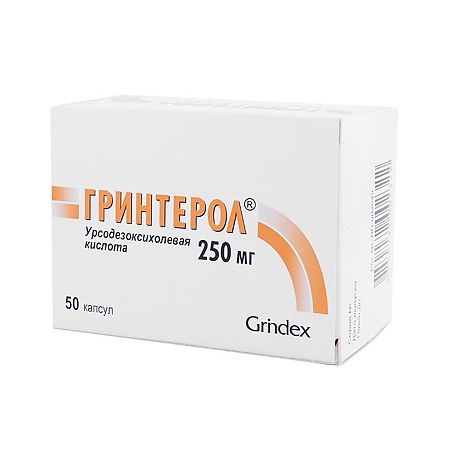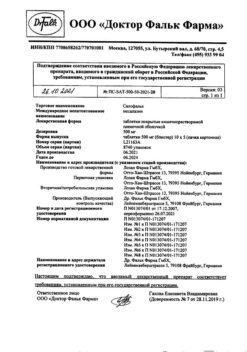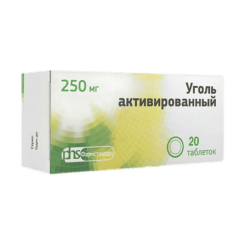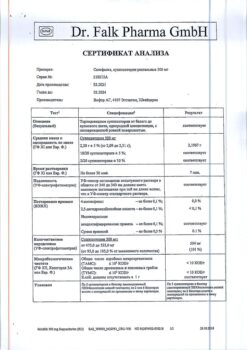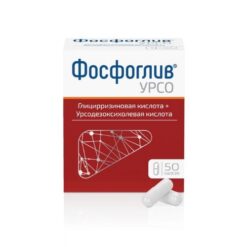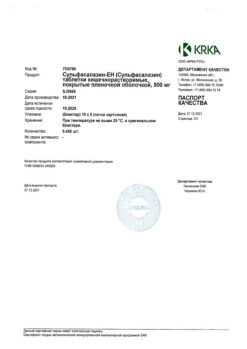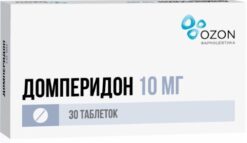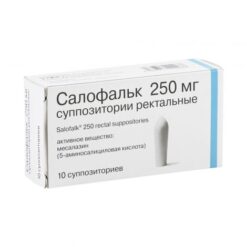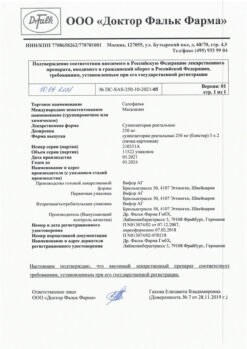No products in the cart.
Grinterol, capsules 250 mg 50 pcs
€17.84 €15.46
Description
Pharmacodynamics
Hepatoprotective agent, also has choleretic, cholestolytic, hypolipidemic, hypocholesterolemic and some immunomodulatory action.
It is incorporated into the membrane of the hepatocyte, stabilizes its structure and protects the hepatocyte from the damaging effects of bile acids salts, thus reducing their cytotoxic effect. In cholestasis it activates Ca2+-dependent alpha-protease and stimulates exocytosis, decreases concentration of toxic bile acids (chenodeoxycholic, lithocholic, deoxycholic, etc.) which concentrations are increased in patients with chronic liver diseases.
Competitively reduces absorption of lipophilic bile acids in the intestine, increases their “fractional” turnover in enterohepatic circulation, induces choleresis, stimulates bile passage and excretion of toxic bile acids through the intestine. It shields non-polar bile acids (chenodeoxycholic acid), due to which mixed (non-toxic) micelles are formed.
Limits bile cholesterol saturation by reducing the synthesis and secretion of cholesterol in the liver and inhibiting its absorption in the intestine.
Enhances the solubility of cholesterol in the biliary system, stimulates the formation and excretion of bile. It decreases lithogenicity of bile, increases concentration of bile acids in it; it causes intensification of gastric and pancreatic secretion, increases lipase activity and has hypoglycemic effect. Causes partial or complete dissolution of cholesterol gallstones when administered orally, reduces the saturation of bile with cholesterol, which promotes its mobilization from the gallstones.
It has immunomodulatory effect, influences immunological reactions in the liver: it decreases the expression of some histocompatibility antigens – HLA-1 on membrane of hepatocytes and HLA-2 on cholangiocytes, affects the number of T-lymphocytes, interleukin 2 formation, decreases the number of eosinophils, suppresses immunocompetent Ig (first of all IgM).
Pharmacokinetics
Absorption from the small intestine is high (about 90%). It penetrates through the placental barrier. Cmax in oral administration of 50 mg in 30, 60, 90 minutes is 3.8; 5.5; 3.7 mmol/l, respectively. ÒCmax is 1-3 hours. The binding to plasma proteins is high.
Metabolized in the liver (clearance during “primary passage” through the liver) to taurine and glycine conjugates, which are secreted into the bile. The excretion is 50? 70% via the intestine. A small amount of unabsorbed ursodeoxycholic acid enters the large intestine, where it undergoes cleavage by bacteria (7?dehydroxylation); the resulting lithocholic acid is partially absorbed from the colon, but is sulfated in the liver and rapidly excreted as sulfolithocholylglycine or sulfolithocholyltaurine conjugate.
Indications
Indications
Dissolution of small and medium-sized cholesterol stones with a functioning gallbladder,
– biliary reflux gastritis,
– primary biliary cirrhosis of the liver in the absence of signs of decompensation (symptomatic therapy),
– chronic hepatitis of various origins,
– primary sclerosing cholangitis, cystic fibrosis (cystic fibrosis),
– non-alcoholic steatohepatitis,
– alcoholic liver disease (ALD),
– biliary dyskinesia.
Pharmacological effect
Pharmacological effect
Pharmacodynamics
A hepatoprotective agent, it also has choleretic, cholelitholytic, hypolipidemic, hypocholesterolemic and some immunomodulatory effects.
It is embedded in the hepatocyte membrane, stabilizes its structure and protects the hepatocyte from the damaging effects of bile salts, thus reducing their cytotoxic effect. In case of cholestasis, it activates Ca2+-dependent alpha protease and stimulates exocytosis, reduces the concentration of toxic bile acids (chenodeoxycholic, lithocholic, deoxycholic, etc.), the concentrations of which are increased in patients with chronic liver diseases.
Competitively reduces the absorption of lipophilic bile acids in the intestine, increases their “fractional” turnover during enterohepatic circulation, induces choleresis, stimulates the passage of bile and the excretion of toxic bile acids through the intestine. Shields non-polar bile acids (chenodeoxycholic acid), due to which mixed (non-toxic) micelles are formed.
Reduces the saturation of bile with cholesterol by reducing the synthesis and secretion of cholesterol in the liver and inhibiting its absorption in the intestine.
Increases the solubility of cholesterol in the biliary system, stimulates the formation and secretion of bile. Reduces the lithogenicity of bile, increases the concentration of bile acids in it, causes increased gastric and pancreatic secretion, enhances lipase activity, and has a hypoglycemic effect. Causes partial or complete dissolution of cholesterol gallstones when administered orally, reduces the saturation of bile with cholesterol, which promotes its mobilization from gallstones.
It has an immunomodulatory effect, affects immunological reactions in the liver: reduces the expression of some histocompatibility antigens – HLA-1 on the membrane of hepatocytes and HLA-2 on cholangiocytes, affects the number of T-lymphocytes, the formation of interleukin 2, reduces the number of eosinophils, suppresses immunocompetent Ig (primarily IgM).
Pharmacokinetics
Absorption from the small intestine is high (about 90%). Penetrates through the placental barrier. Cmax when taken orally 50 mg after 30, 60, 90 minutes – 3.8; 5.5; 3.7 mmol/l, respectively. TCmax – 1-3 hours. High binding to plasma proteins.
Metabolized in the liver (first pass clearance through the liver) into taurine and glycine conjugates, which are secreted into bile. Excreted 50–70% through the intestines. A small amount of unabsorbed ursodeoxycholic acid enters the large intestine, where it is broken down by bacteria (7-dehydroxylation); the resulting lithocholic acid is partially absorbed from the colon, but is sulfated in the liver and quickly excreted in the form of sulfolithocholylglycine or sulfolitocholyltaurine conjugate.
Special instructions
Special instructions
Treatment should be carried out under the supervision of a physician.
When prescribed for the purpose of dissolving gallstones, it is necessary to control the activity of “liver” transaminases and silk phosphatase, gamma-glutamyl transpeptidase, and bilirubin concentration. Cholecystography should be performed every 4 weeks in the first 3 months of treatment, then every 3 months. The effectiveness of treatment is monitored every 6 months during an ultrasound examination during the first year of therapy.
If elevated levels persist, the drug should be discontinued.
For successful dissolution, it is necessary that the stones are purely cholesterol, no more than 15-20 mm in size, the gallbladder is no more than half filled with stones, and the bile ducts fully retain their function.
After complete dissolution of the stones, it is recommended to continue use for at least 3 months in order to promote the dissolution of stone remains that are too small to be detected.
If partial dissolution of the stones has not occurred within 6-12 months after the start of therapy, it is unlikely that the treatment will be effective.
The discovery of a non-visualized gallbladder during treatment is evidence that complete dissolution of the stones has not occurred, and treatment should be stopped.
In patients with diarrhea, the dosage of ursodeoxycholic acid should be reduced. If diarrhea persists, treatment should be discontinued.
Long-term therapy with high doses of ursodeoxycholic acid (28-30 mg/kg/day) can lead to the development of serious side effects in patients with primary sclerosing cholangitis.
Impact on the ability to drive vehicles and machinery:
There was no effect on the ability to drive vehicles or operate machinery.
Active ingredient
Active ingredient
Ursodeoxycholic acid
Composition
Composition
One capsule contains:
active substance:
ursodeoxycholic acid – 250.0 mg;
excipients:
corn starch – 73.0 mg,
silicon dioxide – 5.0 mg,
magnesium stearate – 2.0 mg;
capsule (body and cap): titanium dioxide (E 171) – 2%, gelatin – up to 100%.
Description:
Hard gelatin capsules No. 0, white body and cap.
Contents: white or almost white powder.
Contraindications
Contraindications
– Hypersensitivity to the components of the drug;
– X-ray positive (high Ca2+ content) gallstones;
– non-functioning gallbladder;
– acute inflammatory diseases of the gallbladder, bile ducts and intestines;
– cirrhosis of the liver in the stage of decompensation;
– severe liver and/or kidney failure;
– pancreatitis;
– children under 3 years of age (for capsules).
With caution:
Children aged 3 to 4 years should use with caution, as it may be difficult to swallow the capsules.
Side Effects
Side Effects
Gastrointestinal disorders: loose stools or diarrhea. When treating primary biliary cirrhosis, acute pain in the right upper abdomen may occur.
Disorders of the liver and biliary tract: calcification of gallstones. During the treatment of primary biliary cirrhosis, transient decompensation of liver cirrhosis may occur (resolves after discontinuation of the drug).
Skin and subcutaneous tissue disorders: allergic reactions (including urticaria).
Interaction
Interaction
Antacids containing aluminum hydroxide, aluminum oxide and ion exchange resins (colestyramine, colestipol) reduce the absorption of ursodeoxycholic acid in the intestine, thus reducing its effectiveness; therefore, the listed drugs should be used 2 hours before taking ursodeoxycholic acid.
Ursodeoxycholic acid may enhance the absorption of cyclosporine from the intestine, so the dose of cyclosporine should be adjusted if used concomitantly.
Ursodeoxycholic acid may reduce the absorption of ciprofloxacin.
Lipid-lowering drugs (especially clofibrate), estrogens, neomycin or progestins, and oral contraceptives increase the saturation of bile with cholesterol and may reduce the ability to dissolve cholesterol gallstones.
Overdose
Overdose
There are no known cases of overdose of ursodeoxycholic acid.
Storage conditions
Storage conditions
Store at a temperature not exceeding 25 ºС.
Keep out of the reach of children.
Shelf life
Shelf life
2 years. Do not use after the expiration date stated on the package.
Manufacturer
Manufacturer
Grindeks JSC, Latvia
Additional information
| Shelf life | 2 years. Do not use after the expiration date stated on the package. |
|---|---|
| Conditions of storage | Store at the temperature not more than 25 ºC. Keep out of reach of children. |
| Manufacturer | Grindex JSC, Latvia |
| Medication form | capsules |
| Brand | Grindex JSC |
Other forms…
Related products
Buy Grinterol, capsules 250 mg 50 pcs with delivery to USA, UK, Europe and over 120 other countries.

